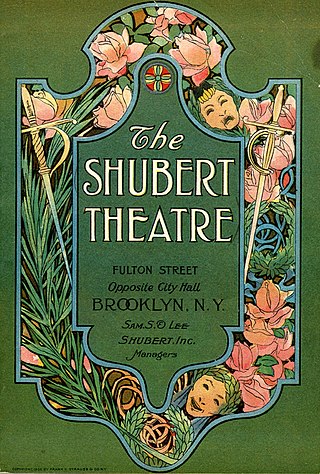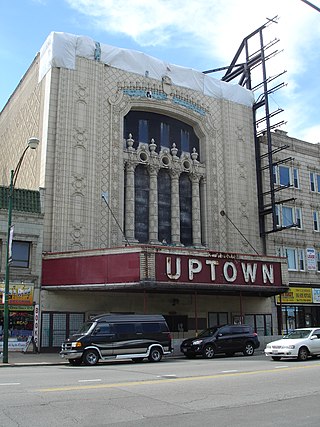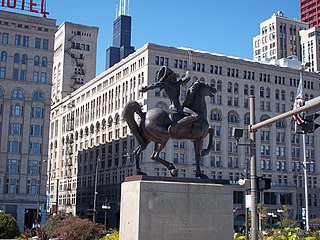
Mary Garden was a Scottish-American operatic lyric soprano, then mezzo-soprano with a substantial career in France and America in the first third of the 20th century. She spent the latter part of her childhood and youth in the United States and eventually became an American citizen, although she lived in France for many years and eventually retired to Scotland, where she spent the last 30 years of her life and died.

Lyric Opera of Chicago is an American opera company based in Chicago, Illinois. The company was founded in Chicago in 1954, under the name 'Lyric Theatre of Chicago' by Carol Fox, Nicola Rescigno and Lawrence Kelly, with a season that included Maria Callas's American debut in Norma. Fox re-organized the company in 1956 under its present name. Lyric is housed in a theater and related spaces in the Civic Opera Building. These spaces are now owned by Lyric.

The Shubert Organization is a theatrical producing organization and a major owner of theatres based in Manhattan, New York City. It was founded by the three Shubert brothers — Lee, Sam, and Jacob J. Shubert — in the late 19th century. They steadily expanded, owning many theaters in New York and across the United States. Since then it has gone through changes of ownership, but it is still a major theater chain.

A movie palace is a large, elaborately decorated movie theater built from the 1910s to the 1940s. The late 1920s saw the peak of the movie palace, with hundreds opening every year between 1925 and 1930. With the advent of television, movie attendance dropped, while the rising popularity of large multiplex chains in the 1980s and 1990s signaled the obsolescence of single-screen theaters. Many movie palaces were razed or converted into multiple-screen venues or performing arts centers, though some have undergone restoration and reopened to the public as historic buildings.

The Joffrey Ballet is an American dance company and training institution in Chicago, Illinois. The Joffrey regularly performs classical and contemporary ballets during its annual performance season at the Civic Opera House, including its annual presentation of The Nutcracker.

The Woodstock Opera House is a historical venue for performing arts and receptions located in Woodstock, Illinois. It was built in 1889 and designed as a multi-use facility with space for city administration offices as well as police and fire departments. The building was planned by architect Smith Hoag and built by contractor Simon Brink for a cost of $25,000. Today, the City of Woodstock still owns the building, but the building is used exclusively as a performance space.

The Auditorium Theatre is a music and performance venue located in the Auditorium Building at 50 E. Ida B. Wells Drive in Chicago, Illinois. Inspired by the Richardsonian Romanesque Style of architect Henry Hobson Richardson, the building was designed by Dankmar Adler and Louis Sullivan and completed in 1889. The Chicago Symphony Orchestra performed in the theatre until 1904 as well as the Chicago Grand Opera Company and its successors the Chicago Opera Association and Chicago Civic Opera until its relocation to the Civic Opera House in 1929. The theater was home to the Joffrey Ballet from 1998 until 2020. It currently hosts a variety of concerts, musicals, performances, and events. Since the 1940s, it has been owned by Roosevelt University and since the 1960s it has been refurbished and managed by an independent non-profit arts organization.

Myrtle Stedman was an American leading lady and later character actress in motion pictures who began in silent films in 1910.

The Civic Opera House, also called Lyric Opera House is an opera house located at 20 North Wacker Drive in Chicago. The Civic's main performance space, named for Ardis Krainik, seats 3,563, making it the second-largest opera auditorium in North America, after the Metropolitan Opera House. Built for the Chicago Civic Opera, it has been home to the Lyric Opera of Chicago since 1954 and the Joffrey Ballet since 2021. It is part of a complex with a 45-story office tower and two 22-story wings, known as the Civic Opera Building that opened November 4, 1929 and features Art Deco details.

The Chautauqua Auditorium is a wooden building constructed for the first season of the Colorado Chautauqua in 1898, and through the years has been a venue for many lectures, musical performances, and motion pictures both primitive and modern.

John Adolph Emil Eberson was an Austrian-American architect best known for the development and promotion of movie palace designs in the atmospheric theatre style. He designed over 500 theatres in his lifetime, earning the nickname "Opera House John". His most notable surviving theatres in the United States include the Tampa Theatre (1926), Palace Theatre Marion (1928), Palace Theatre Louisville (1928), Majestic Theatre (1929), Akron Civic Theatre (1929), the Paramount Theatre (1929), the State Theater 1927, and the Lewis J. Warner Memorial Theater (1932) at Worcester Academy in Worcester, Massachusetts. Remaining international examples in the atmospheric style include both the Capitol Theatre (1928) and State Theatre (1929) in Sydney, Australia, The Forum and Le Grand Rex.
The San Carlo Opera Company was the name of two different opera companies active in the United States during the first half of the twentieth century.
The Civic Opera Company (1922–1931) was a Chicago company that produced seven seasons of grand opera in the Auditorium Theatre from 1922 to 1928, and three seasons at its own Civic Opera House from 1929 to 1931 before falling victim to financial difficulties brought on in part by the Great Depression. The company consisted largely of the remnants of the Chicago Opera Association, a company that produced seven seasons of grand opera in the Auditorium Theatre from 1915 until its bankruptcy in 1921.

Two grand opera companies in Chicago, Illinois, have gone by the name Chicago Grand Opera Company during the first half of the 20th century. Like many opera ventures in Chicago, both succumbed to financial difficulties within a few years, and it wasn't until 1954 that a lasting company was formed in the city.
The Chicago Opera Company was a grand opera company in Chicago, organized from the remaining assets of the bankrupt Chicago City Opera Company, that produced six seasons of opera at the Civic Opera House from 1940 to 1946. Artistic directors included Carlo Peroni (1941–1942) and Fausto Cleva (1944–1946), and until 1945 Fortune Gallo was general manager. After the war, when consumer goods became more abundant and people spent less money on entertainment, interest in opera collapsed and the company went bankrupt. Rather than try to re-organize, the remaining assets were given to the largest creditor, the landlord of the Civic Opera House, Household Finance, who then paid off the other remaining creditors. After the final collapse of an opera company that had been re-organized five times, there was no resident Chicago opera company until the founding of the Lyric Opera in 1954. One of the original group of organizers was Max Rabinoff.

The Philadelphia Grand Opera Company was the name of four different American opera companies active at the Academy of Music in Philadelphia, Pennsylvania during the twentieth century. The last and best known of the four was founded in November 1954 with the merger of the Philadelphia Civic Grand Opera Company and the Philadelphia La Scala Opera Company. That company in turn merged with the Philadelphia Lyric Opera Company in 1975 to form the Opera Company of Philadelphia. Of the three earlier companies, only one lasted beyond one season; a company founded in 1926 which later became associated with the Curtis Institute of Music in 1929. That company closed its doors in 1932 due to financial reasons during the Great Depression.

The Metropolitan Opera House is a historic opera house and current pop concert venue located in Philadelphia, Pennsylvania. It has been used for many different purposes over its history. Now known as The Met, the theatre reopened in December 2018, after a complete renovation, as a concert venue. It is managed by Live Nation Philadelphia.

Myrna Docia Sharlow was an American soprano who had an active performance career in operas and concerts during the 1910s through the 1930s. She began her career in 1912 with the Boston Opera Company and became one of Chicago's more active sopranos from 1915–1920, and again in 1923–1924 and 1926–1927. She sang with several other important American opera companies during her career, including one season at the Metropolitan Opera. She made only a handful of opera appearances in Europe during her career, most notably singing in the English premiere of Riccardo Zandonai's Francesca da Rimini at Covent Garden in 1914. Her repertoire spanned a wide range from leading dramatic soprano roles to lighter lyric soprano fair and comprimario parts. She even performed a few roles traditionally sung by mezzo-sopranos or contraltos.
Alfredo Gandolfi, sometimes given as Alfred Gandolfi, was an Italian-born American cinematographer, operatic baritone, and librettist. He should not be confused with the Alfredo Gandolfi who co-founded Ambrosio Film with Arturo Ambrosio in 1906.